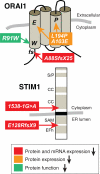Immunodeficiency due to defects in store-operated calcium entry
- PMID: 22129055
- PMCID: PMC3774594
- DOI: 10.1111/j.1749-6632.2011.06240.x
Immunodeficiency due to defects in store-operated calcium entry
Abstract
Mutations in genes encoding the calcium-release activated calcium (CRAC) channel abolish calcium influx in cells of the immune system and cause severe congenital immunodeficiency. Patients with autosomal recessive mutations in the CRAC channel gene ORAI1, its activator stromal interaction molecule 1 (STIM1), and mice with targeted deletion of Orai1, Stim1, and Stim2 genes reveal important roles for CRAC channels in adaptive and innate immune responses to infection and in autoimmunity. Because CRAC channels have important functions outside the immune system, deficiency of either ORAI1 or STIM1 is associated with a unique clinical phenotype. This review will give an overview of CRAC channel function in the immune system, examine the consequences of CRAC channel deficiency for immunity in human patients and mice, and discuss genetic defects in immunoreceptor-associated signaling molecules that compromise calcium influx and cause immunodeficiency.
© 2011 New York Academy of Sciences.
Figures



References
-
- Whitfield JF, Perris AD, Youdale T. The role of calcium in the mitotic stimulation of rat thymocytes by detergents, agmatine and poly-L-lysine. Exp. Cell. Res. 1968;53:155–165. - PubMed
-
- Whitfield JF, Rixon RH, Perris AD, Youdale T. Stimulation by calcium of the entry of thymic lymphocytes into the deoxyribonucleic acid-synthetic (S) phase of the cell cycle. Exp Cell Res. 1969;57:8–12. - PubMed
-
- Lewis RS. Calcium signaling mechanisms in T lymphocytes. Annu Rev Immunol. 2001;19:497–521. - PubMed
-
- Feske S. Calcium signalling in lymphocyte activation and disease. Nat Rev Immunol. 2007;7:690–702. - PubMed
Publication types
MeSH terms
Substances
Grants and funding
LinkOut - more resources
Full Text Sources
Other Literature Sources
Molecular Biology Databases

